From the garden of Lynn O’Malley, voice of the valley:
For the past two months, the LynnValleyLife team has been planning and promoting its scheme to blanket Lynn Valley in summertime sunflowers. We’ve talked sunflowers, mailed sunflowers, photo’d sunflowers and dreamt sunflowers. It occurred to me that amidst all the fuss, I might forget to actually plant the darn things!
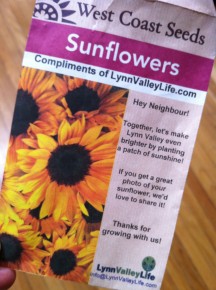 But this weekend all the stars were in alignment. After last week’s late-season frosts, the nights have now warmed up, and the weatherman promises sunshine throughout the week ahead. I put all busy work aside, and decided that today was a perfect day to launch Project Sunflower in the O’Malley plot.
But this weekend all the stars were in alignment. After last week’s late-season frosts, the nights have now warmed up, and the weatherman promises sunshine throughout the week ahead. I put all busy work aside, and decided that today was a perfect day to launch Project Sunflower in the O’Malley plot.
I thought I’d start a Project Sunflower diary here on LynnValleyLife, to inspire people to take part, to (hopefully) answer questions, and to post photos and stories sent in by proud sunflower-growers. I’m not known for my green thumb, so I figured that if I can coax a seed from seedlinghood through to maturity, then the rest of Lynn Valley has no excuse for opting out (we still have more free seed packets available, so email us at [email protected] if you’d like to grow along with us. You can do it for the warm glow you will get from bringing happiness to those walking by your garden, or – insert evil laugh – you can set your sights on winning our prize for tallest or most sunflowers. See this post for details.)
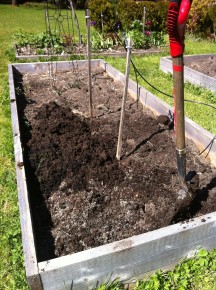 First step was to do a final weed of the raised beds in the front garden. These are usually saved for beans, zucchini, chard and the like, but as we usually mange to harvest enough over the course of a season to save approximately a whooping $5.28 at the supermarket, we thought giving over one of these beds to Project Sunflower would not cause undue hardship. I picked the bed nearest the street, which is designed to maximize sun exposure and admiring glances from passers-by.
First step was to do a final weed of the raised beds in the front garden. These are usually saved for beans, zucchini, chard and the like, but as we usually mange to harvest enough over the course of a season to save approximately a whooping $5.28 at the supermarket, we thought giving over one of these beds to Project Sunflower would not cause undue hardship. I picked the bed nearest the street, which is designed to maximize sun exposure and admiring glances from passers-by.
Once it was weeded, I sprinkled into the soil a mixture of three basic substances that are standard organic soil amendments. I would be more specific about the ingredients, but I mixed the concoction last fall and now I’ve forgotten what’s in it. Something to do with bonemeal and …. something. Apparently you don’t have to be too fussy about your soil with sunflowers, but I had it on hand so I thought it couldn’t hurt (famous last words). And, by the way, when I say I “sprinkled” it on, I mean “threw it on in damp, smelly clumps” because it seems I left the container in the rain at some point over the past few months. (See what I mean about my non-green thumb? Follow this column’s advice at your own peril.)
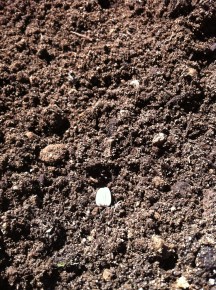 I planted the seeds at the recommended six-inch intervals, at half an inch deep. I went to town and planted a whole packet, because I am determined to have a sunflower patch to be reckoned with. I was watched throughout this process by our garden’s resident crow, who struts about constantly looking self-possessed and calculating. Knowing that crows carry grudges against people they don’t like, and even tell their children and friends about particular individuals they despise, I am carefully polite to him and we have developed a mutual understanding. I have told him about Project Sunflower and respectfully requested his support, so I am hoping he will stay away from the seeds and seedlings. We’ll see.
I planted the seeds at the recommended six-inch intervals, at half an inch deep. I went to town and planted a whole packet, because I am determined to have a sunflower patch to be reckoned with. I was watched throughout this process by our garden’s resident crow, who struts about constantly looking self-possessed and calculating. Knowing that crows carry grudges against people they don’t like, and even tell their children and friends about particular individuals they despise, I am carefully polite to him and we have developed a mutual understanding. I have told him about Project Sunflower and respectfully requested his support, so I am hoping he will stay away from the seeds and seedlings. We’ll see.
Next, I watered the plot. If there is any advice you might want to take away from this post, it is the following: when screwing your ‘water wand’ watering attachment to the end of your hose for the first time in the season, you MAY WISH – this is just a suggestion, mind you – you may wish to test it gently at first, rather than cranking the water pressure full blast while closely examining the seal between the component parts, just in case winter warping has caused said seal to be ineffective, and you have your hat and sunglasses blasted off by the resulting escape of high-velocity water and are left standing in your driveway, dripping wet from drenched head to sodden toe. It’s just a suggestion.
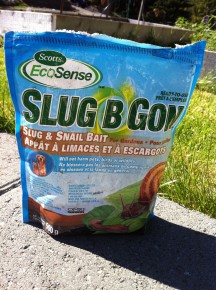 Once the plot was nicely damp, I sprinkled on some natural slug bait I bought a year or two ago that proved to be quite effective. (Stalking slugs at nightfall with a pair of scissors is also quite effective, but labour-intensive and admittedly gruesome.)
Once the plot was nicely damp, I sprinkled on some natural slug bait I bought a year or two ago that proved to be quite effective. (Stalking slugs at nightfall with a pair of scissors is also quite effective, but labour-intensive and admittedly gruesome.)
Over the sunny week ahead, I will be zealous in my soil-moisture monitoring, and hope for shoots in the next few weeks. I will be sure to report back with photos as soon as the first sprout is crowning! In the meantime, please do get your own seeds planted if you haven’t already. All tips and anecdotes welcome – just send them to [email protected]. Tara from the Lynn Valley Garden Club told me that she planted her seeds today, too, and plans to use the sturdy growing stems as a trellis for her cucumber plants – there’s a pro for you!
You can meet Tara and other garden club members at their annual plant sale that takes place next weekend at St. Clement’s Church. They have been working like beavers potting up perennials, digging shrubs, growing tomatoes and doing a thousand other tasks to give shoppers a great selection of growing things to choose from. Watch our blog for more details over the week ahead, but be sure to put Saturday, May 11 on your calendar, from 10 a.m. to 1 p.m.
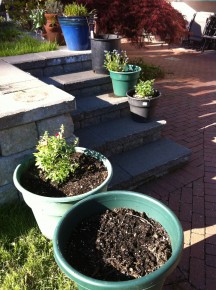 And one final suggestion: while you’re out planting sunflowers in your own garden, why not take a few of those old plastic flower pots we all have kicking around, and plant some seeds for a friend or neighbour who might not be planting their own? I have planted several pots of seeds, which can be given away or moved around my own garden. Sunflowers don’t take too well to being transplanted, so I am using pots that I (hope) are large enough to see them right through to maturity. Don’t tell Mr. O’Malley, though – I have assured him that the pots are all planted with the cucumbers and tomatoes he requested! (Roll that evil laugh again…)
And one final suggestion: while you’re out planting sunflowers in your own garden, why not take a few of those old plastic flower pots we all have kicking around, and plant some seeds for a friend or neighbour who might not be planting their own? I have planted several pots of seeds, which can be given away or moved around my own garden. Sunflowers don’t take too well to being transplanted, so I am using pots that I (hope) are large enough to see them right through to maturity. Don’t tell Mr. O’Malley, though – I have assured him that the pots are all planted with the cucumbers and tomatoes he requested! (Roll that evil laugh again…)

